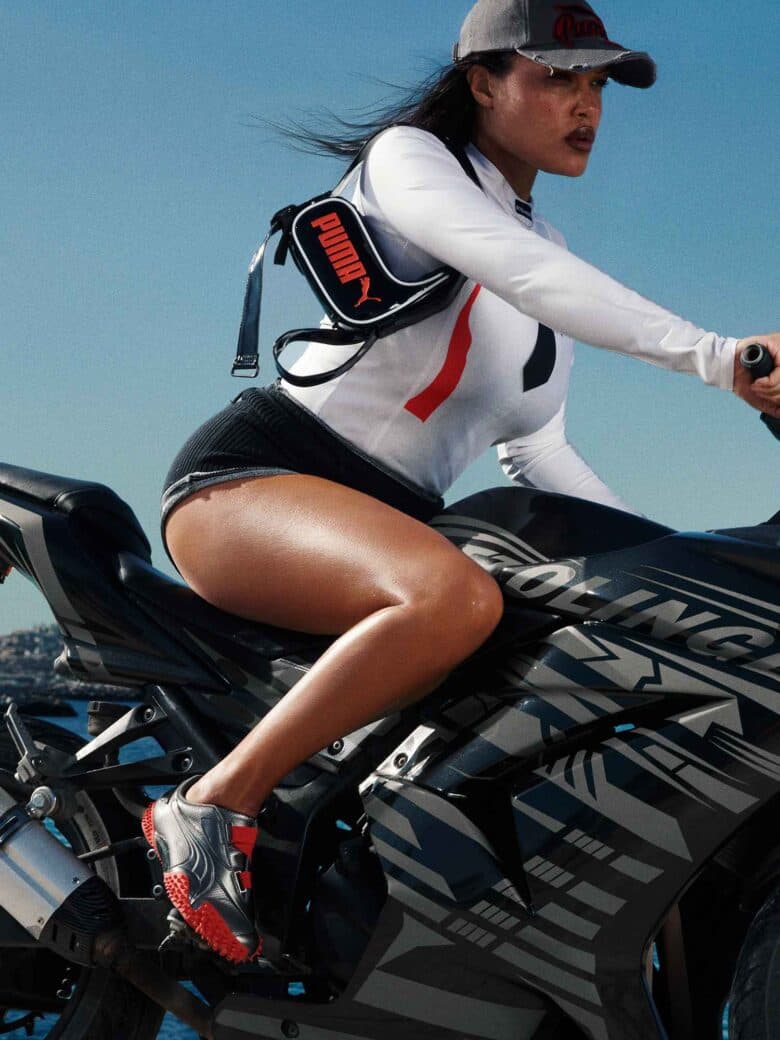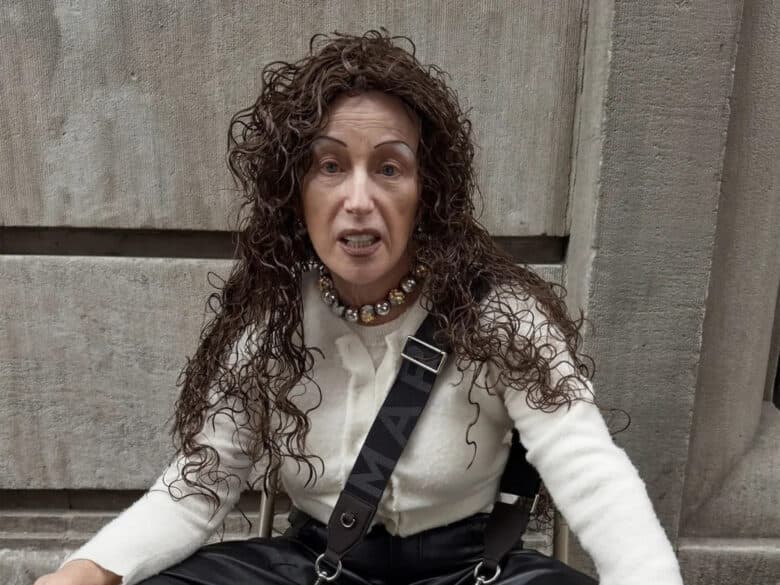Elena Garrigolas: “What I’m doing now is a healing process”
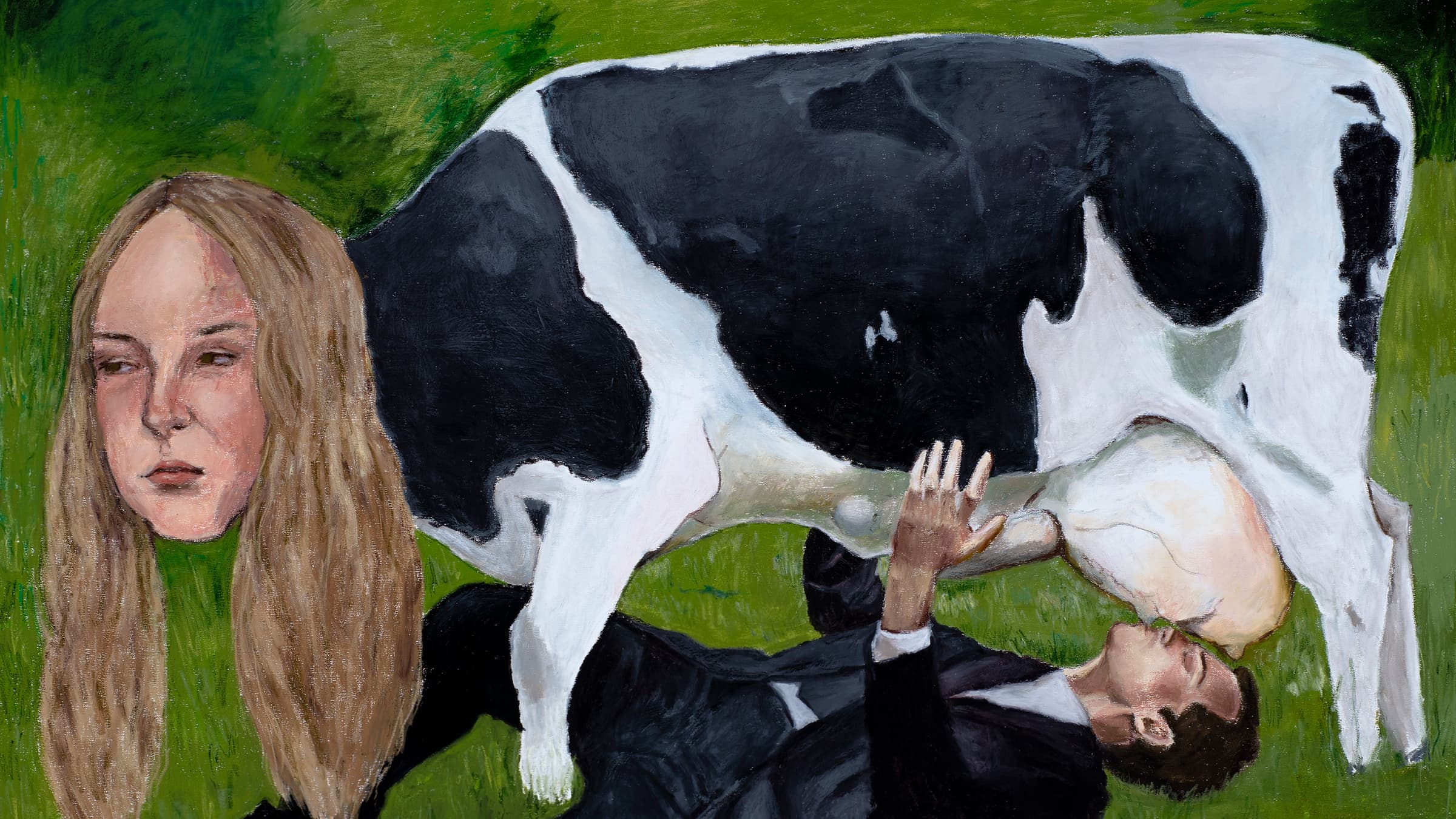
For Elena Garrigolas, everything seems like it’s happening all at once. The night before the 25-year-old artist arrived back at London’s Saatchi Yates Gallery for our interview, she was mixing with the crowd for the opening night of her debut UK exhibition, some of her family by her side, and navigating the emotions of being an artist in the spotlight. Up until now, her career has been made online, creating deeply personal drawings – oftentimes bringing her to tears when she finished one – that were for herself, and sometimes sold off to the right buyer. So it was strange, for her second time in London, hours away from her home in Spain, to be seeing the impact of her work and simultaneously thrown into such a reception.
“I don’t like to be in the spotlight. It’s just about the art. I hate when people approach me,” she says, without a note of hate in her voice – more a statement of modesty, a want to reject any vanity that might come with a night all about her. “Everyone grabbed me by the hand. Everyone wanted a picture. There was even one man that went to talk to my siblings, and he was like, ‘I hate this, but my parents forced me to come here’. He started to criticise my work, and then he came to me to get a picture and he posted it on Instagram.” – An annoyingly apt welcome into the art world.
One day, only some months ago, the gallery reached out to Garrigolas on Instagram and asked her to take her drawings and blow them up to fit around the gallery’s prime space in Green Park. At the time, it was small scale, both in terms of the size of the art and in terms of Garrigolas’ career. “They contacted me and they told me about 17 [drawings] that they wanted,” she says, still taking it all in. In a matter of months, the artist took to her make-shift studio space to turn her deeply introspective work, make them sizeably bigger, and display them for the majority of London’s art world to see.
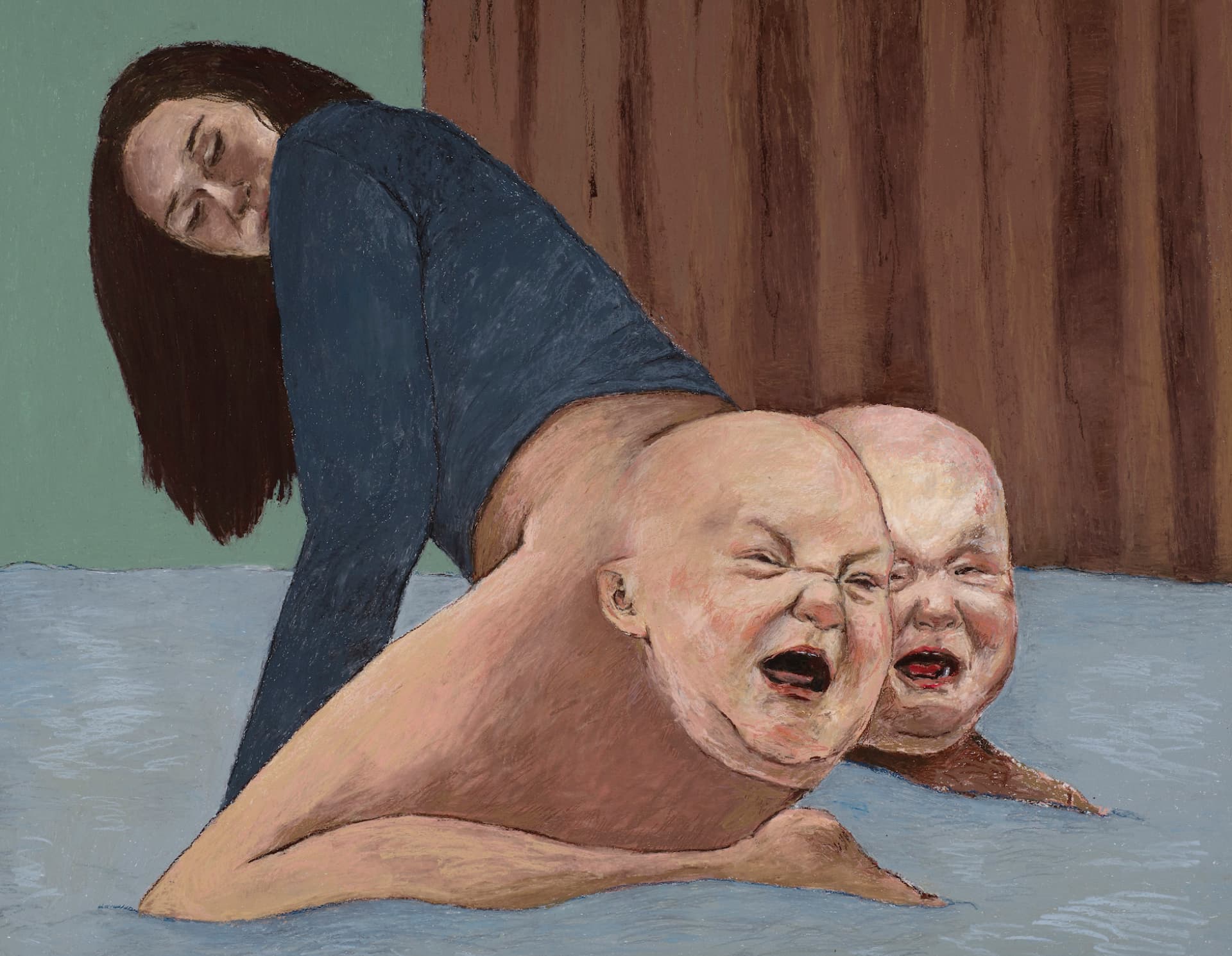
“It’s like exposing myself, like being naked in front of everyone,” Garrigolas continues. “It’s really weird because I’ve always been so closed off within myself. I was worried that people wouldn’t get it, but mostly women would. I was craving that female energy, I guess, and a female response. I really got that.”
The artist’s work puts a split down the middle of any audience. To some, they are humorous pieces that mine at meme culture and weird corners of the internet; weaving discomfort together with funny art that you might set as the background on your phone or repost with the caption “mood”. Or, and as Garrigolas has found from the feedback from numerous women, you might relate to the pain, guilt and discomfort etched into the very essence of the work. They’re pieces that are indeed sometimes inspired by the internet, though deeper than that, they deconstruct her experiences with religion and her family. But what’s more is that Garrigolas has taken the world surrounding the 25-year-old and churned it together with personal experiences, trauma, and deflection (hence the humour). This concoction creates works that aren’t only layered, they’re reflections of what the viewer feels at the time.
As Garrigolas shakes hands with the crowds in the early days of her career, she sits down with HUNGER to discuss everything that went into where she is now…
Congratulations on the show, Elena. Do you enjoy everything that comes with this… The interviews and talking about your work?
The thing is that it’s so personal that I always have to talk about my back story. I talk about my upbringing, I talk about my family, stuff that really hurts me. And talking about that with strangers is really weird. I don’t really have to tell anybody about my life, you know? One man got mad at me because I didn’t want to tell him about one specific work.
Because most of what you create is so personal, and that means that when people ask about your work you have to approach personal conversations, does that make you want to create work that is a bit more detached from your personal truth in the future?
What I’m doing now is a healing process. So I hope that I stay away from that. I did like three paintings that are more tender because I was asked to by the gallery and it was really hard for me to create a nice, tender picture. So I think that once I’m healed or I will stay away from that and I will try.
Which are the more “tender” paintings?
There’s the Portrait of a Man Playing the Cello. There’s the lobster one [Forever, and ever, and ever, 2023]. It’s not tender, but it’s not really what I would normally do. [The gallery] wanted me to make another painting, and I just couldn’t think of anything. So I was like, I’ll do whatever. And they liked it.
The Covid pandemic was quite a pivotal time in your career for you, right?
It really helped me. That’s why I started to sell stuff by myself. I created a site and I would draw small pieces every day. I was more comfortable doing small pieces and also because it was easier to ship.
What was it like selling these pieces of work that are quite visceral and very personal?
Some of them I wouldn’t sell because they were self portraits and I felt really weird about someone having that hanging on their wall. It was mostly men who followed me at the beginning and they would find them funny. I wanted to make sure that they would understand [the art] because I don’t want a weirdo having something that, to me, is painful and, for them, it’s just sexual or whatever, because I’ve gotten so many people confuse my work for more sexual stuff.
And do you notice a big difference in responses to your work from men compared to the responses from women?
One man approached me and said something sexual about one of the pieces, and I was like, ‘I’m not going to talk about sex or with you’. Another man grabbed my hand and started kissing it. One woman came before the opening [of the show] and she started crying because she felt the sadness and the pain. She felt this connection with my work and her life. One girl said that she felt like the one on the couch, like the snail one [Self Portrait (Snail Woman), 2023] – she gets the feeling, and the cow one [My Milkshake Brings All The Boys To The Farm, 2023], for example.
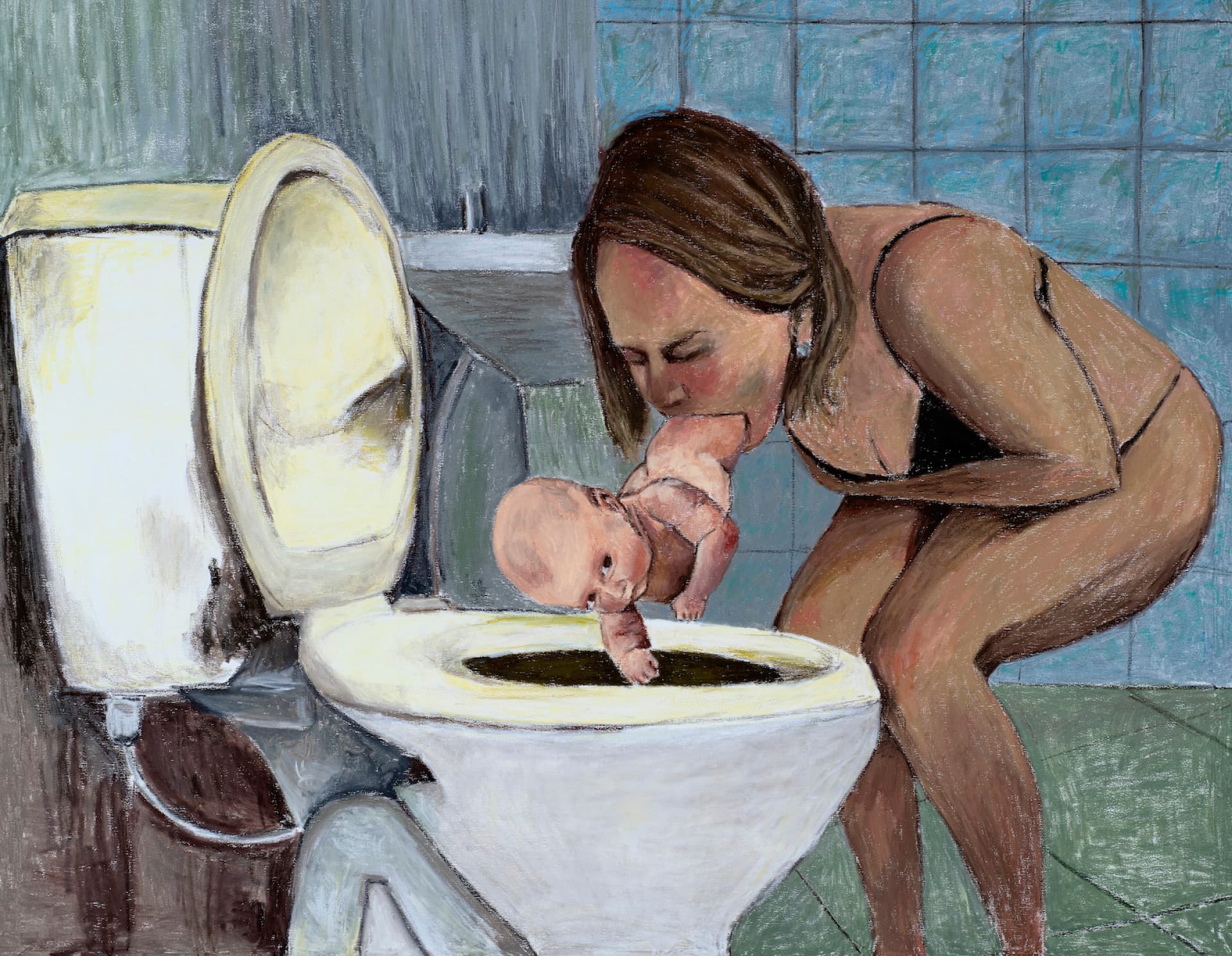
So there’s the acceptable, quite wonderful reactions from women and the completely inappropriate ones from men. But creating work that brings someone to tears is incredibly powerful. How did it feel to experience that?
I’ve never had this feedback in real life because on Instagram people tell me they like it, but I don’t feel it really because it’s so cold through the phone. Back in Spain, I’ve had some exhibitions, but they weren’t in galleries, they were friends who had an open space. People come in but I never received that response. I feel like people [in London] have a knowledge of art, and they get it. In Spain, I’ve never received really good feedback there. So it was a shock.
Do you think it is, as you say, an understanding of art, or is it more of a cultural thing that means viewers see your work in different ways?
I don’t know if it’s Spain or the city I live in, but people are really close minded where I live and religion is also very present. Everything I do is based on religion. I think it’s just that people are close minded and most people don’t know about art history. They just like to see beautiful things like what you see in real life, like a landscape or a bridge, a cathedral, stuff like that. And when they see, I don’t know, a woman puking up a baby, they think of abortion and say, ‘what’s going on with you? You are crazy’.
It’s interesting that people would say that painting reminds them of abortion. Does it mean that to you?
No, to me it’s more my relationship with my mum and how I felt rejected by her from a very young age. I like to not be really accurate on everything. It’s just a metaphor for me, because I sometimes think about stuff and I can’t really put it into words and I just see the image. That’s how I usually work.
Being tasked by the gallery to make these works – many bigger versions of the deeply personal and hard-hitting subjects you were approaching in the past – in such a short space of time must have been an equally, if not more, difficult process?
I didn’t like the process because when I draw, I need to get it out. It’s a moment of pain, for example, or something that happened to me and I let it out on a piece of paper. Taking that same stuff and redoing it, to me, it just loses everything. The fact that [the paintings are] big makes me feel like I don’t want to be exposed like that. To me, I like small stuff. It’s how I am, it’s my personality. It’s like a diary to me and I’m opening it and I’m letting you read it.
There’s obviously some stark differences between how people view your work, and with an artist like that, and artists in general, there can be a difference between how people describe the artist and how the artist describes themself. In light of that, many people say that you’re a feminist artist. Would you say that’s what you are?
[Words can be] overused, like ‘empowering’ and ‘feminism’. Of course, it is feminism, but to me, I don’t think that I want to make feminist art. There’s this quote that says that ‘the personal is political’, and I like to stand by that. I just want to tell my story, and know my experiences with my body myself. I don’t want to put a tag on it. I think people use words so something sells better. For example, in the catalogue they said that I like Frida Kahlo and I never said that, you know?
How inspired by the internet and meme culture are you?
When I started, I really liked stock images. You know, people making a salad and smiling. Really weird stuff. And then, people that post really weird stuff on the internet, such as collages where they put lots of mouths on a vagina. That really got me. I’m inspired by weird music and weird movies. I’m really into metal, and music videos.
Well it’s nice to look at your work and see how you have taken those things from the world around you and allowed them to pass through you and turn them into your work…
I liked to collect images and take pictures. I have a folder on my computer of things that inspire me. Sometimes I look at them and I think I have to do that, when I relate it to something that happened to me, or maybe I can give it another meaning.
Let’s go into some themes. Religion is a huge part of your work, like you say. Is there any part of you that’s still religious now?
No.
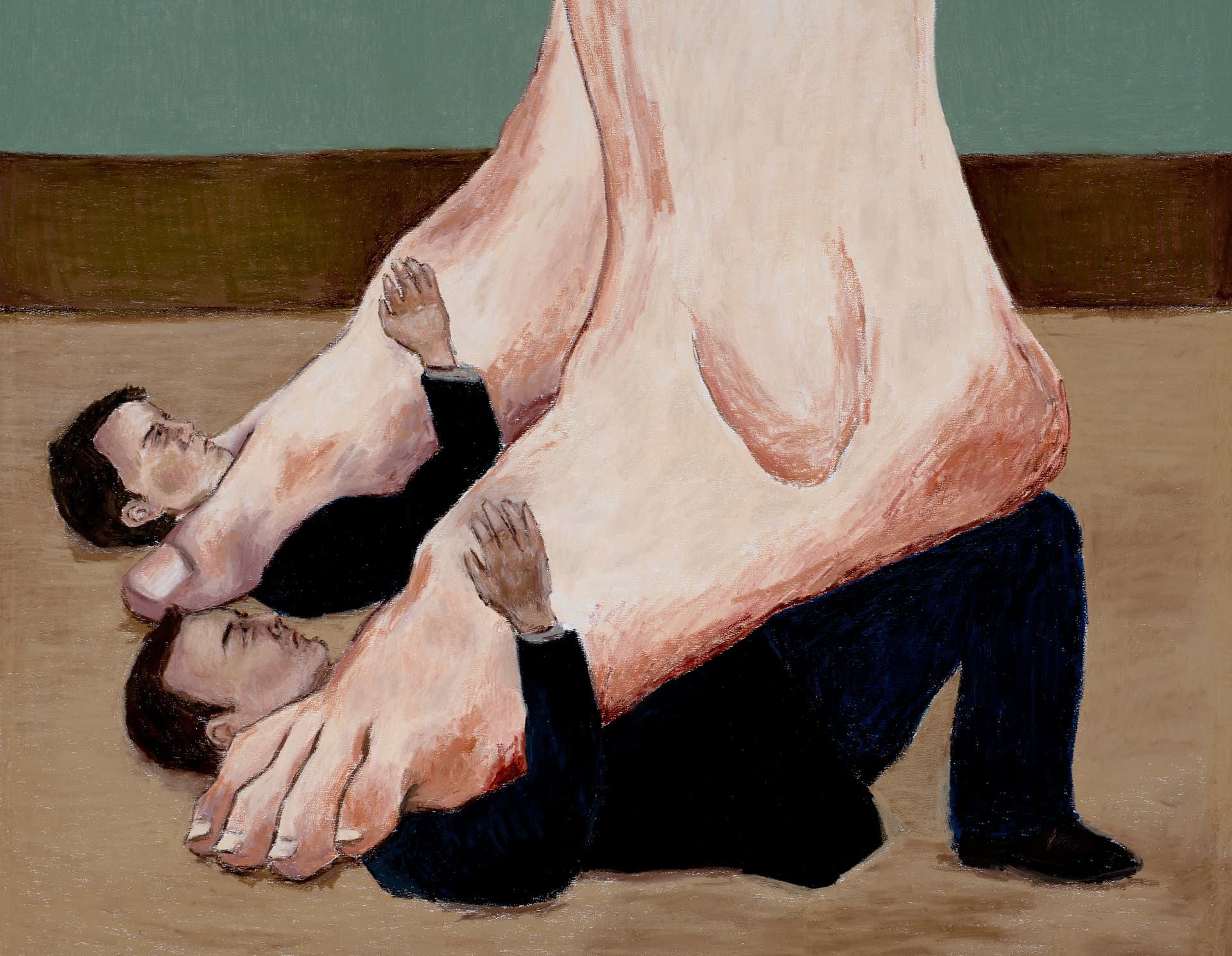
Right. Because even though your work is a lot to do with your experience of religion, there isn’t any standout religious iconography of sorts. Or am I just looking in the wrong places?
I talk so much about myself and religion, my family, my upbringing. I went to a Catholic all girls school and it was really cult-y. I was living in a bubble for the first 18 years of my life. And so that really affected me, everything about me. When I tried to speak up or talk about my feelings, I would just be mute because I was shut down. So I had this issue with expressing myself.
So would you say that a lot of the imagery in your work is a product of the impact of religion on you, not necessarily a comment on religion as a whole?
It’s like everything that I’ve been taught; hide your body, hate your body, don’t be with men, don’t have sex – all that shame I still have.
And what does the idea, the notion even, of ‘home’ mean to you?
It’s really sad because I’ve never felt safer at home, anywhere, with anyone. So, I don’t know. I’m trying to find it. I feel like I need to leave. I’m thinking about going to Italy. I don’t even know where or I don’t even want to book anything. I just want to live and be by myself… To be calm, because it’s been too much for me.
Do you feel like that about Spain as a whole?
I want to leave Spain. For a while at least. I have no clue of what I want to do in the future or anything. I just know that I’m not okay where I am. So I need to make some changes.
When you say you don’t know what you want to do in the future, do you want to be an artist in the future?
Yeah, for sure. But I never expected this to happen. I would just draw every day and to me that was nice. I don’t want to be famous, I don’t want to be known. I hate that.
What about animals, what do they mean to you?
I really like animals and I really hate what we are doing to them. For example, depicting the cow as myself and having someone drinking from me, that’s also talking about how we treat animals. It’s not just a metaphor.
Yes, there’s a cyclical feeling in your work of we’re all one-and-the-same with animals – you can feel that. In that as well, there’s also lots of pointers towards life and death, sometimes conjuring similar feelings at the same time.
I’ve always had a strange relationship with death because I never cry [when someone dies] and it’s really weird and I always feel bad. I know some people that think about their own death and they get sad, but I don’t care. I just think that you die and everything is over, all the fame is gone. I like to play with the dualism of is something dead or is it alive, or if it’s both.
Finally, is there anything that you want people to know about your work?
I would just like them to really try to read and understand what they are saying about the work.
Thank you, Elena.
